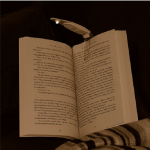For the bookworms amongst us here’s nothing better than spending those winter evenings curled up with a good paperback.
But it’s crucial we have the correct lighting, not only so we can read the pages (obviously!) but also because poor lighting can seriously affect our eyesight and prove detrimental to our vision over time. It can also lead to eye strain, migraines, and blurred vision.
So if we intend reading the latest bestseller well into our octogenarian years then we’d better do our best to keep our orbs in good condition. Although it may create a more romantic, cozy ambiance, there really isn’t any need to read by candlelight anymore – there’s that wonderful thing called electricity.
Here are some good, practical advice on what to look for in a good reading lamp and the best lights to use to ensure many long years of happy, headache-free reading.
What Lamp To Choose?
Using a lamp with a bendable neck will help you read a lot more comfortable, and a flexible lamp allows you to angle the light in a position exactly where you want it, which reduces glare and unnecessary straining.
Flexible lamps also usually provide better light than overhead lighting, plus they’re a good way of cutting back on energy costs and conserving lighting as using them means you don’t have to illuminate the whole room.
LED lamps are also proving to be increasingly popular due to their longevity, so are become the lamp of choice for many ardent readers. And because these lights come in a variety of strengths, you can work out which brightness works best for you. (Just make sure you replace them when their power starts to fade and they become dimmer.)
Light Positioning
The light should ideally come from behind to light up the page, and it goes without saying it shouldn’t shine directly into your eyes. Floor standing lamps are good for positioning next your chair or sofa, as are anglepoise lamps (which have previously been far from attractive but now come in a variety of more aesthetically pleasing designs).
It’s generally recommended that you use a hundred watt lamp for reading, though it may be worth consulting your optician for the best advice if you don’t feel this is adequate.
Many of us are also partial to reading in bed for an hour or two before we go to sleep, so choosing a good bedside lamp is important. If it’s too low, not only will it cause eye strain but back pain as you’ll have to keep leaning forward. In these circumstances, again, LED lights are very effective as you can dim them to control the amount of light you need.
What To Avoid
Avoid high-intensity lamps as these cast shadows and often create glare and, if possible, place a dim light either side of your so you’re creating an area of equal brightness without the dark, shadowed areas.
So while it may be cold and dark outside, lights in your home for reading are important to ensure you get the most out of the next few chapters of your latest bestseller.
Have you got any lighting recommendations for those hardcore readers out there?


